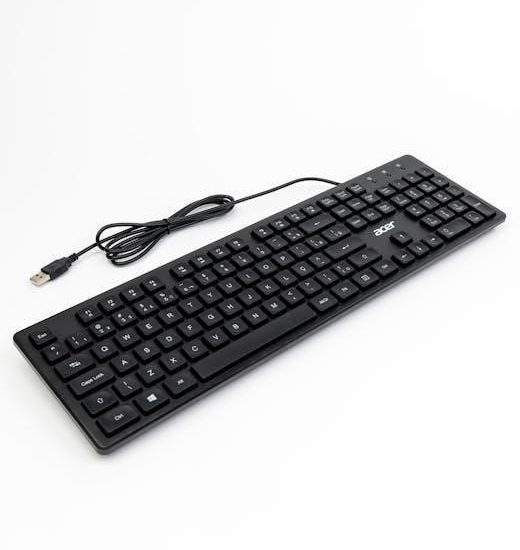MIG wire serves as a filler material in Gas Metal Arc Welding, crucial for achieving desired weld quality, strength, and appearance․ Wire size selection is vital for optimal welding results․
What is MIG Wire?
MIG (Metal Inert Gas) wire is a consumable filler material used in Gas Metal Arc Welding (GMAW)․ It is a continuous wire electrode fed through a welding gun, creating an electric arc that melts the wire and joins metals․ Available in various materials like steel, stainless steel, aluminum, and nickel alloys, MIG wire is chosen based on the metals being welded․ Its diameter and composition significantly impact weld strength, penetration, and appearance․ Proper wire selection ensures optimal welding performance, making it a critical component in industries such as automotive, construction, and manufacturing․ The wire’s quality and consistency are essential for achieving durable and high-quality welds in diverse applications․
Importance of Wire Size in MIG Welding
Wire size plays a critical role in MIG welding, directly influencing weld quality, penetration, and appearance․ The diameter of the wire determines the amount of heat input and the volume of filler metal deposited․ A smaller wire diameter is ideal for thin materials, as it reduces the risk of burn-through and allows for precise control․ Conversely, larger wires are better suited for thicker materials, providing deeper penetration and stronger welds․ Proper wire size selection ensures efficient energy transfer, stable arc performance, and minimal spatter․ It also affects the welder’s ability to achieve smooth, consistent beads․ Choosing the wrong wire size can lead to inadequate fusion, porosity, or excessive heat damage, making it essential to match the wire to the specific welding application and material thickness․
Standard MIG Wire Sizes
Standard MIG wire sizes range from 0․023″ to 0․045″, with 0․030″ and 0․035″ being the most common․ Wire diameters are chosen based on metal thickness and welding application․
Common Wire Diameters
Common MIG wire diameters range from 0․023″ to 0․045″, with 0․030″ and 0․035″ being the most frequently used․ Thinner wires (0․023″-0․030″) are ideal for thin materials, precision work, and delicate joints, offering better control and minimal heat input․ Thicker wires (0․035″-0․045″) are suited for heavier materials, providing deeper penetration and higher strength․ The choice of diameter depends on the thickness of the base metal, the type of metal being welded, and the desired weld appearance․ For example, 0․030″ wire is often used for automotive bodywork, while 0․035″ wire is common in industrial fabrication․ Selecting the right diameter ensures proper fusion, avoids burn-through, and optimizes the welding process for specific applications․
Wire Material Types
MIG wires are available in various materials, each suited for specific welding applications․ Steel wires, such as ER70S-6, are the most common, offering excellent strength and versatility for mild steel․ Stainless steel wires, like ER308L, are ideal for corrosion-resistant applications, ensuring durability in harsh environments․ Aluminum wires, such as ER5356, are used for welding aluminum alloys, providing excellent conductivity and weldability․ Nickel-based wires, like ERNiCrMo-3, are utilized for high-temperature and corrosion-resistant welding, often in specialized industries․ The choice of wire material depends on the base metal being welded, ensuring compatibility and desired weld properties․ Proper material selection is critical for achieving strong, durable, and visually appealing welds in various industrial and fabrication projects․
Wire Classification and Ratings
MIG wires are classified based on their material composition, weld performance, and intended use․ Common classifications include ER70S-6 for mild steel, ER308L for stainless steel, and ER5356 for aluminum․ These classifications indicate the wire’s compatibility with specific base metals and desired weld properties․ Ratings often refer to the wire’s tensile strength, elongation, and corrosion resistance, ensuring reliability in various applications․ Proper classification ensures the wire meets industry standards for strength, durability, and weld quality․ Understanding wire classifications is essential for selecting the right material for the job, ensuring optimal results in welding processes․ Always refer to the manufacturer’s specifications to match the wire type with the base metal and welding requirements․ This ensures strong, consistent, and high-quality welds in industrial, automotive, and fabrication projects․
Factors Influencing MIG Wire Size Selection
Base metal thickness, type of metal, welding position, power source voltage, and shielding gas all influence MIG wire size selection to ensure optimal weld quality and penetration․

Thickness of the Base Metal
The thickness of the base metal is a critical factor in selecting the appropriate MIG wire size․ Thicker materials require larger diameter wires to ensure sufficient penetration and strength․ For instance, a 0․045-inch wire is often used for 1/4-inch steel, while a 0․052-inch wire may be necessary for thicker sections․ Using too small a wire can result in inadequate penetration, leading to weak welds․ Conversely, a wire that is too large may cause excessive heat input, potentially warping thinner materials․ Proper wire size selection ensures the weld penetrates fully without damaging the base metal, maintaining structural integrity and appearance․ This balance is essential for achieving professional-grade welding results․
Type of Metal Being Welded
The type of metal being welded significantly influences the choice of MIG wire size․ Different metals have unique chemical compositions and physical properties, requiring specific wire alloys to ensure compatibility and optimal weld quality․ For example, steel typically uses ER70S-6 wires, while stainless steel requires ER308L or ER316L wires to maintain corrosion resistance․ Aluminum welding often involves ER4043 or ER5356 wires due to their high thermal conductivity and corrosion resistance․ Specialty metals, such as nickel or titanium, also demand specialized wires to match their properties․ Selecting the correct wire alloy ensures proper fusion, avoids contamination, and maintains the desired mechanical and corrosion-resistant properties of the weld․ This compatibility is crucial for achieving strong, durable, and visually appealing welds across various metal types․
Welding Position
The welding position significantly impacts the choice of MIG wire size, as it affects the weld pool dynamics and the wire’s ability to maintain consistent feed․ Flat-position welding typically allows for larger wire diameters, promoting higher deposition rates and faster welding speeds; Vertical and overhead welding, however, may require smaller wire sizes to prevent sagging and maintain control over the weld pool․ The angle at which the weld is performed influences the gravitational pull on the molten metal, making smaller wires easier to handle in non-flat positions․ Additionally, the welding position can affect the required arc characteristics, with smaller wires often providing better arc stability in challenging orientations․ Selecting the appropriate wire size for the position ensures better control, penetration, and overall weld quality․ This adaptability is essential for achieving consistent results across various welding scenarios․
Power Source and Voltage
The power source and voltage play a crucial role in determining the appropriate MIG wire size․ The type of power source, whether DC (direct current) or AC (alternating current), influences the wire’s performance․ DC is more commonly used in MIG welding due to its consistent arc characteristics․ Voltage settings directly affect the wire’s melting rate and arc stability․ Higher voltage typically allows for larger wire diameters, as it increases the energy input and melting capacity․ Conversely, lower voltage settings are better suited for thinner materials, requiring smaller wire sizes to avoid excessive heat and distortion․ Matching the wire size to the power source and voltage ensures optimal arc stability, proper weld penetration, and minimized spatter․ This balance is essential for achieving high-quality welds in various applications․ Proper voltage adjustment helps maintain consistent wire feed and arc characteristics․
Shielding Gas Used
The shielding gas used in MIG welding significantly impacts wire size selection and weld quality․ Common shielding gases include argon, helium, and mixtures of these, as well as active gases like CO2․ The type of gas affects the arc characteristics, penetration, and weld appearance․ For example, pure argon provides a clean, stable arc, making it ideal for thinner materials and smaller wire diameters․ Conversely, CO2 or argon-CO2 blends are often used for thicker materials, requiring larger wire sizes to maintain proper penetration․ The shielding gas also influences the wire’s electrical conductivity and melting rate․ Selecting the right gas ensures compatibility with the wire size, base metal, and desired weld properties․ Proper gas selection is critical for achieving consistent and high-quality results in MIG welding applications․ Always consult the wire manufacturer’s recommendations for optimal gas pairings․ This ensures the best outcomes for specific projects and materials․ Shielding gas choice directly affects the efficiency and effectiveness of the welding process, making it a key factor in wire size selection․ Proper gas selection ensures compatibility with the wire size, base metal, and desired weld properties․ Always consult the wire manufacturer’s recommendations for optimal gas pairings․ This ensures the best outcomes for specific projects and materials․ Shielding gas choice directly affects the efficiency and effectiveness of the welding process, making it a key factor in wire size selection․

Applications of Different MIG Wire Sizes
- Thinner wires (0․6-0․8mm) are ideal for automotive and DIY projects requiring precision and minimal heat input․
- Thicker wires (1․0-1․2mm) suit industrial fabrication and heavy-duty applications, ensuring strong welds on thicker materials․
- Specialized wires are used for high-strength steel, offering enhanced durability and resistance to stress․
Automotive Welding
In automotive welding, MIG wire size selection is critical for achieving strong, durable welds on vehicle components․ Thinner wires (0․6-0․8mm) are often used for sheet metal and body panels to minimize heat input and distortion․ Heavier wires (1․0-1․2mm) are preferred for frame repairs and high-strength applications, ensuring superior penetration and weld integrity․ Automotive welders frequently use ER70S-6 or ER80S-D2 wires for steel, while ER4043 or ER5350 are chosen for aluminum․ Proper wire selection ensures clean, corrosion-resistant welds, essential for maintaining vehicle safety and performance․ Additionally, automotive applications often require wires with low spatter and high feedability to meet industry standards for appearance and reliability․
Industrial Fabrication
In industrial fabrication, MIG wire size plays a crucial role in ensuring robust and long-lasting welds for heavy-duty applications․ Thicker wires, such as 1․0mm to 1․6mm, are commonly used for welding thick steel plates, machinery components, and structural frameworks․ These larger diameters provide deeper penetration and higher strength, essential for withstanding stress and load․ ER70S-6 is a popular choice for steel fabrication, while ER308L and ER4043 are often used for stainless steel and aluminum, respectively․ Proper wire selection ensures minimal distortion and maximum weld integrity, critical for industrial-scale projects; Additionally, high feed speeds and consistent voltage settings are essential to maintain productivity and quality in large-scale fabrication environments․
DIY and Home Projects
In DIY and home projects, MIG wire size selection is crucial for achieving clean, durable welds․ For most household tasks, such as repairing furniture or small metalwork, a 0․8mm to 1․0mm wire diameter is ideal․ Thinner wires are easier to handle for beginners and work well on thinner materials like sheet metal or small steel frames․ ER70S-6 is a versatile choice for steel, while ER4043 is preferred for aluminum․ When working on thinner materials, a smaller wire ensures less heat input, reducing the risk of warping․ For thicker materials, a slightly larger wire diameter provides better penetration․ Always match the wire size to the thickness of the metal and the desired weld appearance․ Experiment with different settings to achieve the perfect balance for your project;
High-Strength Steel Welding
For high-strength steel welding, selecting the right MIG wire size is critical to maintain the material’s tensile strength and durability․ A 1․2mm or 1․6mm wire diameter is often recommended, as it provides sufficient penetration without compromising the steel’s structural integrity․ Wire materials like ER70S-6 or ER100S-G are ideal, as they are designed for high-strength applications․ Proper shielding gas, such as a 75% argon/25% CO2 mix, ensures clean welds and prevents porosity․ Using the correct wire size and material ensures the weld retains the steel’s original properties, making it suitable for heavy-duty applications․ Always refer to the steel manufacturer’s recommendations for optimal results and to avoid defects like lack of fusion or cracking․

Choosing the Right Wire Size
Selecting the correct MIG wire size involves considering the base metal’s thickness, welding position, power source, and shielding gas․ Proper sizing ensures optimal weld quality and penetration․
Understanding Wire Feed Speed
Wire feed speed is a critical parameter in MIG welding, directly affecting weld quality and penetration․ It refers to the rate at which the welding wire is fed through the gun and into the arc․ Proper wire feed speed ensures consistent arc stability and prevents issues like porosity or lack of fusion․ The speed is typically measured in inches per minute (IPM) or meters per minute (MPM)․ Factors like wire diameter, base metal thickness, and desired weld penetration influence the optimal feed rate․ For example, thicker wires or heavier materials often require higher feed speeds․ Adjusting the wire feed speed correctly balances the energy input and wire deposition rate, ensuring a smooth, controlled welding process․ Starting with manufacturer-recommended settings and fine-tuning based on visual inspection is a practical approach․ Modern MIG welders often include built-in calculators or charts to help determine the ideal feed speed for specific applications․
Weld Penetration and Appearance
Weld penetration and appearance are directly influenced by the MIG wire size and welding parameters․ Proper penetration ensures the weld fuses thoroughly with the base metal, while appearance affects the weld’s visual quality․ Larger wire diameters typically produce deeper penetration but may result in a coarser weld bead․ Smaller wires create finer, more aesthetic welds with less penetration․ The wire size must be chosen based on the base metal’s thickness and the desired weld properties․ Incorrect wire size can lead to insufficient penetration or an overly visible, uneven weld surface․ Adjusting voltage, current, and wire feed speed helps achieve the ideal balance between penetration and appearance, ensuring both strength and attractiveness in the finished weld․
Selecting the Correct Wire Diameter
Selecting the correct MIG wire diameter ensures optimal weld quality and performance․ The diameter must match the thickness of the base metal, with thinner wires (e․g․, 0․023″) suited for delicate or thin materials, while thicker wires (e․g․, 0․045″) are ideal for heavier materials․ The welding position also plays a role; for example, horizontal or vertical welding may require a slightly larger diameter for better control․ Material type, such as steel, aluminum, or stainless steel, further influences the choice, as each has specific wire recommendations․ Always consult wire classification charts to align the diameter with the required strength and appearance․ Proper selection enhances joint strength, reduces porosity, and ensures a smooth, consistent weld finish, making it a critical step in achieving professional-grade results․

Best Practices for MIG Wire Usage
- Store wire in a dry, clean environment to prevent contamination․
- Handle wire gently to avoid kinks or damage․
- Use the correct voltage and wire feed settings for optimal results․
- Keep the welding area clean to ensure high-quality welds․
- Inspect wire regularly for signs of wear or degradation․
Proper Storage of MIG Wire
Storing MIG wire correctly is essential to maintain its quality and performance․ Always keep the wire in a clean, dry, and cool environment, away from direct sunlight and moisture․ Store the wire in its original packaging or a sealed container to prevent contamination․ Ensure the storage area is free from dust and debris, as these can damage the wire․ Avoid exposing the wire to extreme temperatures or humidity, as this can cause rust or degradation․ If the wire is partially used, reseal it tightly in its packaging to maintain its condition․ Proper storage ensures consistent weld quality and prevents issues like porosity or irregular arc behavior․ Regularly inspect stored wire for signs of damage or degradation before use․
Maintenance of Wire Feeder
Regular maintenance of the wire feeder is crucial for smooth MIG welding operations․ Clean the feeder regularly to remove dirt, dust, and debris that can cause wire feed issues․ Use compressed air to blow out particles from the feeder and drive roll․ Lubricate moving parts, such as bearings and rollers, to ensure smooth operation․ Inspect the drive roll and replace it if worn or damaged, as this can lead to inconsistent wire feeding․ Check the tension settings to ensure they are appropriate for the wire size and type․ Properly align the wire feeder with the welding gun to prevent kinking or tangling․ Regularly inspect and replace worn or damaged components, such as the feeder’s liner, to maintain consistent wire feed speed and prevent downtime․
Handling and Replacing Welding Tips
Proper handling and replacement of welding tips are essential for maintaining MIG welding performance․ Always handle tips with care to avoid bending or misaligning the nozzles․ Clean the tip regularly using a tip cleaner or wire brush to remove spatter and ensure consistent arc stability․ When replacing tips, select the correct size and type to match your MIG wire and welding application․ A mismatched tip can lead to poor weld quality or wire feeding issues․ Install the new tip securely, ensuring it is tightly fastened and properly aligned․ After replacement, test the weld to confirm optimal performance․ Regularly inspect tips for wear, such as erosion or excessive spatter buildup, and replace them as needed to maintain precision and prevent downtime․

Troubleshooting Common Issues
Identify and address issues like improper wire feeding, poor arc stability, or insufficient penetration by adjusting wire size, voltage, or shielding gas to optimize weld quality․
Poor Arc Stability
Poor arc stability can lead to inconsistent welds and reduced quality․ It often occurs when the MIG wire size is mismatched with the power source or shielding gas․ Incorrect wire diameter can disrupt the arc’s consistency, causing it to stutter or wander․ Additionally, using the wrong type of shielding gas or insufficient gas flow can destabilize the arc․ To resolve this, ensure the wire size aligns with the recommended voltage range for your welder․ Check the shielding gas type and flow rate, as improper settings can disrupt the arc․ Clean the wire feeder and tip regularly to prevent debris from affecting wire feeding․ Adjusting the wire feed speed may also help stabilize the arc․ Proper setup and maintenance are key to achieving a smooth, consistent welding process․
Insufficient Weld Penetration

Insufficient weld penetration is a common issue that can weaken the weld joint․ It often occurs when the MIG wire size is too small for the thickness of the base metal, resulting in inadequate heat input․ Using a wire diameter that is too thin may not generate enough current to melt through thicker materials․ Additionally, incorrect voltage settings or low wire feed speed can reduce the arc’s energy, leading to shallow penetration․ To address this, select a larger wire diameter suitable for the metal thickness and adjust the voltage higher to increase heat input․ Ensuring proper shielding gas flow and maintaining a consistent arc length also help improve penetration depth․ Always refer to the wire manufacturer’s recommendations for optimal settings based on your specific welding application․
Wire Feed Problems
Wire feed issues are common in MIG welding and can disrupt the welding process․ A faulty or clogged wire feeder, incorrect tension settings, or a damaged welding torch liner can cause the wire to feed unevenly or stop feeding altogether․ Using the wrong wire size for the feeder or improper alignment of the wire guide can also lead to feeding problems․ Additionally, tangled or kinked wire spools may restrict smooth wire flow․ Regular maintenance, such as cleaning the feeder and ensuring proper wire alignment, can prevent these issues․ Always check the wire feeder’s tension and replace worn-out components to maintain consistent wire feed speed and achieve reliable welding results․ Proper handling and storage of the wire spool can also minimize feeding difficulties during welding operations․
Future Trends in MIG Welding

Advancements include automation, robotics, and eco-friendly practices․ New wire materials and energy-efficient systems are being developed to enhance performance and sustainability in welding processes globally․
Advanced Wire Materials

Research into advanced wire materials is revolutionizing MIG welding․ High-performance alloys, such as titanium and nickel-based wires, are gaining traction for their superior strength and corrosion resistance․ Composite wires, blending metals with ceramics, are being developed to enhance durability and heat resistance․ Additionally, eco-friendly wires made from recycled materials are emerging, reducing environmental impact․ These innovations are driven by the demand for lightweight, high-strength components in industries like aerospace and automotive․ Furthermore, advanced materials are being designed to improve weld penetration and reduce spatter, ensuring cleaner and more efficient welding processes․ The integration of these materials with automation and robotics promises to optimize production and reduce waste in manufacturing․ As technology advances, the development of specialized wires will continue to play a crucial role in shaping the future of MIG welding․
Automation and Robotics
Automation and robotics are transforming MIG welding by enhancing precision, speed, and consistency․ Robotic systems, equipped with advanced sensors and AI, optimize wire feed speed and voltage for flawless welds․ They excel in high-volume production, reducing human error and increasing efficiency․ Automation enables seamless integration with CAD designs, ensuring accurate weld placement․ Robotics also excels in complex geometries and tight spaces, making it ideal for automotive and industrial fabrication․ Additionally, automated systems minimize material waste and reduce labor costs․ Their ability to adapt to various wire sizes and materials ensures versatility across projects․ As robotics advances, it’s expected to further streamline MIG welding processes, driving innovation in manufacturing and enabling faster production cycles without compromising quality․
Eco-Friendly Practices
Eco-friendly practices in MIG welding focus on reducing environmental impact while maintaining high-quality results․ Using recyclable materials, such as steel MIG wires, helps minimize waste․ Proper wire sizing and storage reduce waste generation during welding projects․ Energy-efficient power sources and optimized wire feed speeds lower electricity consumption․ Many manufacturers now offer eco-conscious MIG wires with low-fume or no-fume properties, reducing emissions․ Additionally, recycling leftover wire and spools supports sustainable practices․ Eco-friendly shielding gases, like 100% argon, minimize atmospheric impact․ By adopting these methods, welders can reduce their carbon footprint while producing durable, high-quality welds․ Eco-friendly practices not only benefit the environment but also enhance workshop safety and cost efficiency, making them a win-win for modern welding applications․
Selecting the right MIG wire size is crucial for optimal welding results, ensuring strength, efficiency, and durability in various applications․ Always consult a size guide or expert advice for the best outcomes․

Recap of Key Points
Selecting the appropriate MIG wire size is essential for achieving high-quality welds․ Wire size impacts penetration, strength, and aesthetics, making it critical to match the wire diameter to the base metal thickness and type․ Common diameters range from 0․023″ to 0․045″, with smaller wires suited for thin materials and larger wires for thicker metals․ Material types like ER70S-6 and ER4043 cater to specific metals, ensuring compatibility and durability․ Factors such as welding position, power source, and shielding gas also influence wire selection․ Proper storage, maintenance, and handling of the wire feeder and tips are best practices to ensure optimal performance․ Understanding these elements helps in making informed decisions for various welding applications, from automotive to industrial fabrication․
Final Thoughts on MIG Wire Selection
Selecting the right MIG wire size is pivotal for achieving desired weld quality and performance․ Proper wire size ensures optimal penetration, strength, and appearance, tailored to the specific metal and project requirements․ Always consider the base metal thickness, type, and welding conditions when choosing a wire diameter․ Material compatibility, such as ER70S-6 for steel or ER4043 for aluminum, is equally crucial․ Best practices include storing wire in a dry, cool environment and regularly maintaining the wire feeder․ By understanding these factors, welders can enhance safety, efficiency, and results․ Investing time in selecting the correct MIG wire size ensures superior welds and extends equipment longevity, making it a cornerstone of successful welding projects․





